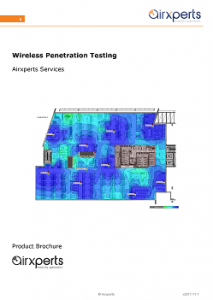What Is It?

A Wireless Penetration Test is an evaluation of the security of your existing Wi-Fi service.
A penetration test is an in-depth assessment of a system, from the point of view of a would-be attacker. The tester constructs a barrage of tests that seeks to exploit vulnerabilities in the solution or the underlying technology.
The test is conducted by a skilled engineer using special software and/or hardware.
A penetration test is not necessarily a complete evaluation of the security posture of your solution, however it may be a crucial step in safeguarding your data and your network.

Note: If you require a comprehensive evaluation of your entire solution, including from a performance and requirements perspective, please consider our Wireless Audit offering.
Do I Need One?
There are several reasons to conduct a penetration test on a wireless solution. For example:
 To eliminate or report on critical vulnerabilities in your environment
To eliminate or report on critical vulnerabilities in your environment- To evaluate the risk and impact of security vulnerabilities in order to prioritise future work
- To comply with an industry standard or to achieve accreditation
- In response to a security incident in your organisation
If any of these situations apply, then a Wireless Penetration Test is something you should consider.
What Will I Gain?
A penetration test should at a minimum:
 Confirm or deny whether you are protected from all known exploits applicable to your system
Confirm or deny whether you are protected from all known exploits applicable to your system- Provide concrete evidence of that protection or lack of it
- List discovered vulnerabilities, including their risk and impact
- Recommend remediation steps
A thorough assessment may, in addition, provide the following:
- Indicate areas where best security practice has not been followed
- Highlight potential areas of vulnerability in your system
- Rate the overall level of security risk found in the system
What is different about securing Wireless networks?
Wireless is somewhat different from traditional wired networking environments in that a would-be attacker does not require physical access to your premises or your equipment to launch an attack.
 Wireless signals by their nature travel long distances. With a suitably powerful receiver/transmitter an attacker can exploit vulnerabilities in your site without ever setting foot near it.
Wireless signals by their nature travel long distances. With a suitably powerful receiver/transmitter an attacker can exploit vulnerabilities in your site without ever setting foot near it.
These facts can make a Penetration Test more critical for wireless networks than for traditional wired networks – since physical security is never sufficient.
Further, a Wi-Fi services employ a complex but varied set of technologies, usually involving many different vendors & systems all working together. For example, identity, authentication and access layer systems are often different products from different vendors.
There are therefore many different opportunities to exploit the system in an enterprise wireless solution.
Our Process
We adopt a 4-phase approach to penetration testing.

This approach has been applied and refined over the course of many small to very large Wi-Fi solutions with great result for you, the customer:
- Scope
- Plan
- Execute
- Report
Phase 1: Scope
It is important to scope the work for your particular systems and solution. This ensures only relevant tests are performed and reported on. We also determine how and where the tests will be performed, and what pre-requisite information and equipment is needed to perform the tests. This phase takes place through a discovery process with the customer.
Phase 2: Plan
The suite of tests is planned. A methodology for each test is determined.
 Phase 3: Execute
Phase 3: Execute
The tests are performed onsite.
Phase 4: Report
The results of the tests are reported on and analysed. Remediation steps are recommended.
What Is Included?
 Your comprehensive Wireless Penetration Testing Report will include:
Your comprehensive Wireless Penetration Testing Report will include:
- Executive Summary
- Technical Summary
- Details of Test Suite
- Detailed Technical Findings, including:
- Risk
- Impact
- Recommended Remediation
- for each discovered vulnerability

